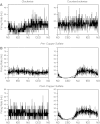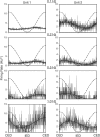Responses of neurons in the caudal medullary lateral tegmental field to visceral inputs and vestibular stimulation in vertical planes
- PMID: 22955058
- PMCID: PMC3517700
- DOI: 10.1152/ajpregu.00356.2012
Responses of neurons in the caudal medullary lateral tegmental field to visceral inputs and vestibular stimulation in vertical planes
Abstract
The dorsolateral reticular formation of the caudal medulla, or the lateral tegmental field (LTF), has been classified as the brain's "vomiting center", as well as an important region in regulating sympathetic outflow. We examined the responses of LTF neurons in cats to rotations of the body that activate vestibular receptors, as well as to stimulation of baroreceptors (through mechanical stretch of the carotid sinus) and gastrointestinal receptors (through the intragastric administration of the emetic compound copper sulfate). Approximately half of the LTF neurons exhibited graviceptive responses to vestibular stimulation, similar to primary afferents innervating otolith organs. The other half of the neurons had complex responses, including spatiotemporal convergence behavior, suggesting that they received convergent inputs from a variety of vestibular receptors. Neurons that received gastrointestinal and baroreceptor inputs had similar complex responses to vestibular stimulation; such responses are expected for neurons that contribute to the generation of motion sickness. LTF units with convergent baroreceptor and vestibular inputs may participate in producing the cardiovascular system components of motion sickness, such as the changes in skin blood flow that result in pallor. The administration of copper sulfate often modulated the gain of responses of LTF neurons to vestibular stimulation, particularly for units whose spontaneous firing rate was altered by infusion of drug (median of 459%). The present results raise the prospect that emetic signals from the gastrointestinal tract modify the processing of vestibular inputs by LTF neurons, thereby affecting the probability that vomiting will occur as a consequence of motion sickness.
Figures








Similar articles
-
Processing of vestibular inputs by the medullary lateral tegmental field of conscious cats: implications for generation of motion sickness.Exp Brain Res. 2013 Mar;225(3):349-59. doi: 10.1007/s00221-012-3376-1. Epub 2012 Dec 29. Exp Brain Res. 2013. PMID: 23274644 Free PMC article.
-
Effects of visceral inputs on the processing of labyrinthine signals by the inferior and caudal medial vestibular nuclei: ramifications for the production of motion sickness.Exp Brain Res. 2013 Jul;228(3):353-63. doi: 10.1007/s00221-013-3568-3. Epub 2013 May 28. Exp Brain Res. 2013. PMID: 23712685 Free PMC article.
-
Responses of neurons in the rostral ventrolateral medulla of the cat to natural vestibular stimulation.Brain Res. 1993 Jan 22;601(1-2):255-64. doi: 10.1016/0006-8993(93)91718-8. Brain Res. 1993. PMID: 8431771
-
Integration of vestibular and emetic gastrointestinal signals that produce nausea and vomiting: potential contributions to motion sickness.Exp Brain Res. 2014 Aug;232(8):2455-69. doi: 10.1007/s00221-014-3937-6. Epub 2014 Apr 16. Exp Brain Res. 2014. PMID: 24736862 Free PMC article. Review.
-
Otolith and canal integration on single vestibular neurons in cats.Exp Brain Res. 2005 Jul;164(3):271-85. doi: 10.1007/s00221-005-2341-7. Epub 2005 Jul 1. Exp Brain Res. 2005. PMID: 15991028 Review.
Cited by
-
Micro RNA 181c-5p: A promising target for post-stroke recovery in socially isolated mice.Neurosci Lett. 2020 Jan 10;715:134610. doi: 10.1016/j.neulet.2019.134610. Epub 2019 Nov 10. Neurosci Lett. 2020. PMID: 31722236 Free PMC article.
-
Processing of vestibular inputs by the medullary lateral tegmental field of conscious cats: implications for generation of motion sickness.Exp Brain Res. 2013 Mar;225(3):349-59. doi: 10.1007/s00221-012-3376-1. Epub 2012 Dec 29. Exp Brain Res. 2013. PMID: 23274644 Free PMC article.
-
Motion sickness: more than nausea and vomiting.Exp Brain Res. 2014 Aug;232(8):2493-510. doi: 10.1007/s00221-014-4008-8. Epub 2014 Jun 25. Exp Brain Res. 2014. PMID: 24961738 Free PMC article.
-
Responses of Neurons in the Medullary Lateral Tegmental Field and Nucleus Tractus Solitarius to Vestibular Stimuli in Conscious Felines.Front Neurol. 2020 Dec 18;11:620817. doi: 10.3389/fneur.2020.620817. eCollection 2020. Front Neurol. 2020. PMID: 33391176 Free PMC article.
-
Vestibulo-sympathetic responses.Compr Physiol. 2014 Apr;4(2):851-87. doi: 10.1002/cphy.c130041. Compr Physiol. 2014. PMID: 24715571 Free PMC article. Review.
References
-
- Anderson JH, Blanks RHI, Precht W. Response characteristics of semicircular canal and otolith systems in the cat. I Dynamic responses of primary vestibular fibers. Exp Brain Res 32: 491–507, 1978 - PubMed
-
- Baker J, Goldberg J, Hermann G, Peterson B. Spatial and temporal response properties of secondary neurons that receive convergent input in vestibular nuclei of alert cats. Brain Res 294: 138–143, 1984 - PubMed
-
- Balaban CD. Vestibular autonomic regulation (including motion sickness and the mechanism of vomiting). Curr Opin Neurol 12: 29–33, 1999 - PubMed
-
- Balaban CD. Vestibular nucleus projections to the parabrachial nucleus in rabbits: implications for vestibular influences on the autonomic nervous system. Exp Brain Res 108: 367–381, 1996 - PubMed
Publication types
MeSH terms
Substances
Grants and funding
LinkOut - more resources
Full Text Sources
Miscellaneous

